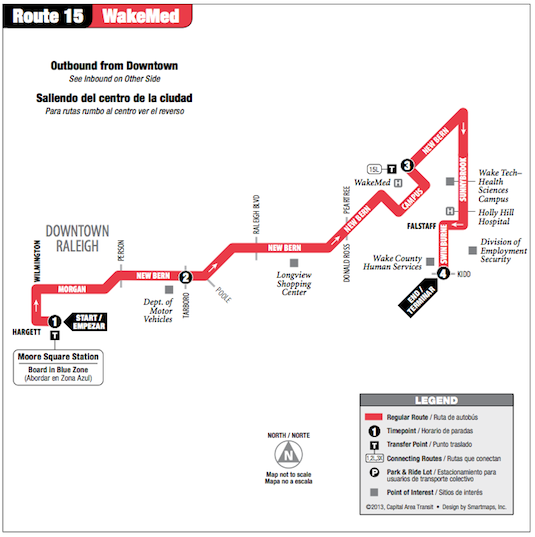If the Raleigh City Council is going to approve a major road project, transportation and transit staff thinks it should be the New Bern Avenue corridor.
During a transportation workshop last week, staff identified the corridor as a top-priority project for increased bus service and bicycle and pedestrian access.
Raleigh Transit Administrator David Eatman said New Bern was chosen over other Raleigh corridors because it is already Capital Area Transit’s most heavily used route. Plans for improving the corridor have already begun with the New Bern Avenue Corridor study approved last year.
“It has a lot going for it in the fact that we wouldn’t be starting from scratch,” Eatman told the Record.
 A map showing one of the CAT bus routes along New Bern Avenue.
A map showing one of the CAT bus routes along New Bern Avenue.
As part of the overall plan, there would be increased bus service and pedestrian infrastructure, such as sidewalks, which could lead to more economic redevelopment in the area.
Eatman said when the project is fully built out, it will have a rail-like experience, with 12 identified stations that will have electronic bus arrival times and route information.
Lanes on New Bern Avenue will be dedicated for buses and right-turn-only during peak hours, and used for either parking or regular traffic flow during off-peak hours.
The traffic lights on New Bern would have signal prioritization so that late-running buses will get green lights to make up time.
Buses would run every 10 minutes during peak hours and every 15 to 30 minutes during off-peak hours and on the weekends.
Project Funding
In total, the city is looking at spending about $39 million in capital costs on the project.
The city could use its own funding or get federal and state funding, both of which come with a set of pros and cons.
If the city uses bond funding, the project could be up and running within the next two to three years. Local funding also comes with fewer federal and state regulations to comply with and fewer strings attached.
With a bonded project, Eatman said, “You control your destiny.”
Obtaining federal and state funding through a Small Starts grant, could delay the project an additional two years. Federal and state funding also comes with more environmental regulations and competition from other applicants.
If such funding was approved, the federal government would pay for about 50 percent of the total cost. If a 25 percent match came from the state, the city would responsible for about $10 million.
Eatman told the Record that state funding is uncertain.
Either way, Eatman said, the rebuilt corridor and better bus service would cost about $1.7 million in annual operating costs.
As part of staff’s short-term goals for the corridor, Eatman said they are looking at how much it would cost to bring service every 15 minutes during peak hours, every 30 minutes during off peak hours and service on the weekends.
